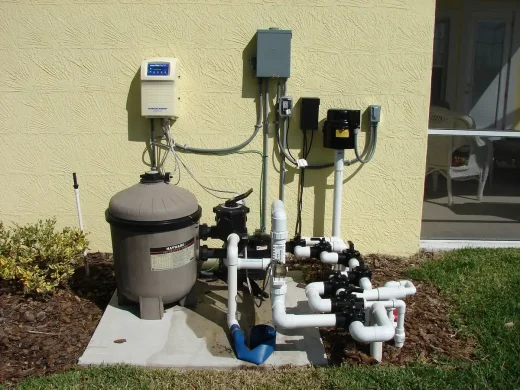The role of water pumps in preventing flood damage in buildings, Home drainage, Building drain tips
The Role of Water Pumps in Preventing Flood Damage in Buildings
February 11, 2025
Flooding poses an ever-present threat to many structures, and the means of countering rising water levels have evolved considerably over time. Modern water pumps serve as a frontline defense in minimizing damage to buildings, protecting valuable assets, and ensuring the continuity of daily life. Unpredictable weather patterns and aging infrastructure have led building owners to seek reliable solutions that quickly remove unwanted water.
This need has given rise to advanced pump systems that combine durability with rapid response capabilities. Protection against water damage preserves structural integrity, reduces long-term repair costs, and minimizes risks to occupants. With careful planning, proper installation, and regular maintenance, water pumps become a critical component of a comprehensive flood prevention strategy that saves lives and properties while supporting community resilience.
Understanding Flood Damage and Building Vulnerabilities
Flood damage manifests in a variety of ways and can weaken a building’s foundation, compromise structural elements, and create conditions that promote mold growth and deterioration. Many structures are vulnerable due to outdated drainage systems, poor waterproofing, or suboptimal construction methods that do not anticipate the challenges posed by severe weather.
Building owners must consider the risks posed by water infiltration, which can lead to costly repairs and even render a structure uninhabitable. Assessing these vulnerabilities requires a thorough understanding of how water interacts with different building materials and how floodwaters travel through urban landscapes.
The Critical Role of Water Pumps in Flood Prevention
Water pumps are indispensable in reducing the impact of floodwaters on buildings. Their ability to move large volumes of water quickly prevents prolonged saturation of floors and walls, thereby averting structural damage and the development of mold. Rapid water removal is essential during flood events, and modern pump systems are engineered to function efficiently under harsh conditions.
These systems often integrate with other building technologies, allowing for seamless operation even when power is disrupted. Pump efficiency and reliability can be the difference between minor water intrusion and catastrophic building damage. When correctly installed, these devices offer protection that supports emergency response and long-term building maintenance. Investment in robust pump systems can significantly reduce repair costs, enhance safety for occupants, and maintain the overall integrity of a building during periods of heavy rainfall and flooding.
Types and Technologies of Flood Prevention Pumps
A wide variety of pump technologies exist to meet the diverse needs of flood prevention in buildings. Pumps range from submersible units designed for continuous operation in flooded basements to high-capacity models suited for commercial or industrial applications. A small but powerful system is available for residential use. Modern water suction pumps offer unmatched efficiency by quickly channeling water away from critical areas. This system, integrated with digital controls and remote monitoring capabilities, provides real-time feedback on water levels and pump performance.
Cutting-edge designs utilize corrosion-resistant materials and energy-efficient motors that can operate continuously during extended flood events. Some pumps are designed to cope with debris-laden water, while others are optimized for rapid deployment and high flow rates. The choice of pump depends on the specific needs of the building, including the volume of water to be managed, the layout of the structure, and environmental factors. Embracing a mix of proven technologies and innovative features ensures that each building can be effectively shielded from the adverse effects of flooding.
Installation Strategies and System Integration
Successful flood prevention depends on more than just having an efficient pump; it requires thoughtful installation and integration within a building’s overall infrastructure. Strategic placement of pumps near potential water entry points, such as basements or crawl spaces, maximizes their effectiveness. Integrating these systems with building management networks allows for coordinated responses to rising water levels, with sensors automatically triggering pump activation when water is detected. Professional installation ensures that pump capacity matches the expected water flow and that discharge lines are directed to safe locations away from the building.
Maintenance Practices for Long-Lasting Performance
Routine maintenance plays a vital role in ensuring that water pumps continue to operate at peak performance during flood events. Regular inspections of electrical connections, seals, and impellers help identify potential issues before they become critical failures. Scheduled servicing by qualified professionals can extend the lifespan of pump systems and maintain optimal flow rates.
Keeping discharge pipes free of blockages and ensuring that sensors are accurately calibrated are equally important. Maintenance protocols should include cleaning of sump pits, checking for corrosion, and verifying the functionality of backup systems. Building owners who invest in regular upkeep not only reduce the likelihood of pump failure during an emergency but also safeguard their investment by preventing costly water damage.
Economic and Safety Benefits of Flood Prevention Pumps
Investing in advanced water pump systems offers significant economic and safety advantages. The immediate removal of floodwaters reduces structural damage, which in turn lowers repair and insurance costs. Studies have shown that every dollar spent on flood mitigation can save multiple dollars in post-disaster recovery expenses. Effective pump systems not only protect physical assets but also contribute to the safety of building occupants by preventing water-related hazards such as slips, falls, and electrical shocks.
In commercial and industrial settings, reducing downtime during flood events can prevent major financial losses and maintain operational continuity. By minimizing water damage, these systems help preserve the value of properties and reduce the burden on municipal emergency services. The long-term benefits of investing in reliable water pump technology extend to improved quality of life and increased property marketability, as prospective buyers and tenants, are more inclined to invest in well-protected, resilient buildings.
Water pump systems are evolving rapidly, and forward-thinking building owners are adopting these technologies to mitigate risk and protect their investments. Enhanced digital controls, improved energy management, and resilient design are setting new benchmarks in flood prevention. Collaborative efforts between manufacturers, building experts, and regulatory bodies are paving the way for standardized, high-performance solutions that meet the challenges of a changing climate. The future of flood prevention is bright, with technology and innovation driving significant improvements in both performance and sustainability.
Building owners who invest in robust flood prevention measures today are not only protecting their assets but also contributing to a safer, more resilient community for tomorrow.
Comments on this guide to The Role of Water Pumps in Preventing Flood Damage in Buildings article are welcome.
Drainage
Drainage Infrastructure and Plumbing Posts
Why it is important to clean blocked drains
Ultimate Drainage Infrastructure Guide
How to get rid of drain flies in one week
Building Articles
Residential Architecture
Comments / photos for the The Role of Water Pumps in Preventing Flood Damage in Buildings page welcome.







